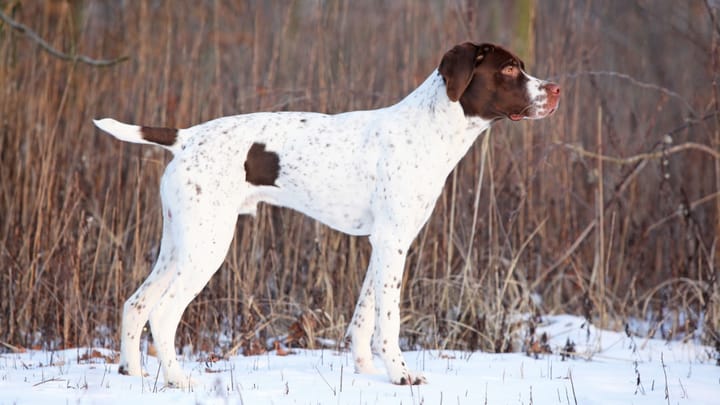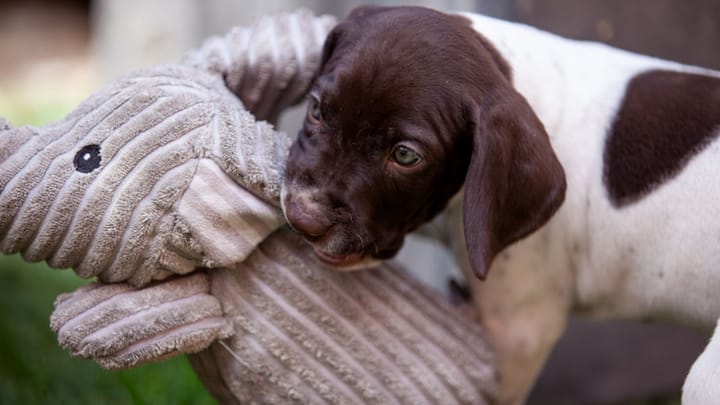French Pointing Dog
Other names : Braque Français, Braque Français Gascogne, Braque Français Pyrenees, Braque Français de Grande Taille, Braque Français de Petite Taille, French Pointer, French Pointer Gascogne, French Pointer Pyrenees, Large French Pointer, Small French Pointer


The Braque Francais dog breed consists of 2 different pointer dog types. The Braque Gascogne and the Braque Pyrénées. During the late 1800s, these two variants of the French Braque hunting dogs were discovered. The Braque Gascogne dog is the larger of the two dogs. During recent years, the Braque Francais dogs have become the most popular of the French pointing dogs.
|
Life expectancy |
The French Pointing Dog has a life expectancy of between 12 and 14 years |
|
Temperament |
|
|
Size |
Large
|
|
Adult size |
Female
Between 22 and 27 in
Male
Between 23 and 27 in
|
|
Adult weight |
Female
Between 37 and 55 lb
Male
Between 37 and 55 lb
|
|
Coat colour
Chestnut brown, either solid or mixed with white, or sometimes white with or without ticking, roan or tan markings. |
White Brown Red |
|
Type of coat
The Braque Francais has a smooth, fairly short coat. The Pyrenean type has a tighter skin, whole the Gascogne type has a loose skin and noticeably thicker hair. |
Very short |
|
Eye colour
Chestnut brown or dark yellow. |
Brown
|
|
Purchase price |
The French Pointing Dog costs between £700 and £900 |
Although the French Pointer is a relatively uncommon and unknown breed, some hunters, especially located in North America, would not hunt with any other breed of dog. Loyal owners are attached to these sporting dogs not only for their sporting abilities, but also due to their intelligence and docile personalities. The very first Braque Francais dog that was taken and introduced to North American hunters was Maffia de l’etang du Marcenac.
More details about the French Pointing Dog
French Pointing Dog: Origins and history
Dating back to the 15th century, the Braque Francais breed of hunting dogs first appeared in the South of France.
Physical characteristics of the French Pointing Dog
As mentioned, there are 2 different types of Braque Francais. One originates from the Southwest of France and the other from the central Pyrenean areas. These dogs are the natural choice for any game and bird hunters, knowing instinctively what needs to be done in the field, without being instructed constantly.
The Braque Gascogne is the larger of the 2 dogs, with a squarer muzzle and a thicker coat. The Pyrenean dog has a finer coat, a broader head and a more mottled-brown coat colour.
FCI classification of the French Pointing Dog
-
Group 7 - Pointing Dogs
-
Section 1 : Continental Pointing Dogs
French Pointing Dog: Varieties
- Braque Français (Pyrenees)
- Braque Français (Gascogne)
French Pointing Dog: Characteristics
French Pointing Dog: Behaviour
Training a French Pointing Dog
As a breed that loves to please their master, this Braque Francais dog responds well to training. However, he can be quite sensitive when corrected, so consistent and gentle training methods are needed.
French Pointing Dog: Lifestyle
Breed compatibility French Pointing Dog
French Pointing Dog: Purchase price
You will expect to pay between £700 to £900 to purchase a Braque Francais dog. In addition, feeding costs, veterinary fees, and pet insurance will cost between £70 to £100 per month.
French Pointing Dog: Shedding
Average
The Braque Francais is considered to be an average shedder. The Braque Gascogne sheds slightly more than the Pyrenean dog.
French Pointing Dog: Grooming
With his sleek coat with short, tight hair, grooming the French Pointer doesn’t need to be time consuming. Daily tooth brushing will help with the dog’s dental health. As this breed has floppy ears, frequent cleaning of them is advised to prevent any infections.
French Pointing Dog: Health
Generally a healthy dog breed with no recognised and documented health issues. Like many other sporting dogs, hip and elbow dysplasia may cause some problems, while eye problems are more common. The average life expectancy for this breed is 12 to 14 years.
Certainly a dog with great stamina, who is able to hunt constantly for many hours.
As the Braque Francais is a short haired dog, he tolerates the heat of the summer quite well.
This breed is capable of hunting over all terrains, in all weathers. Cooler temperatures won’t prevent him carrying out his hunting expeditions. He will happily jump into cold water as he retrieves game birds.
As a very energetic and active dog, he isn’t prone to gaining weight while he is working. However, a more senior dog who lives a sedentary life in the home will be more prone to gaining weight.
- Hip dysplasia
- Elbow dysplasia
- Luxating patella/Patellar luxation
- Cataracts
- Entropion
- Ectropion
- Progressive retinal atrophy/PRA
- Pannus
- Demodicosis/Demodectic mange/Memodex mange
- Cleft lip/palate
- Acral mutilation syndrome
- Aortic stenosis







